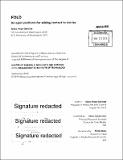| dc.contributor.advisor | Ethan Zuckerman. | en_US |
| dc.contributor.author | Gottlieb, Alexis Hope | en_US |
| dc.contributor.other | Massachusetts Institute of Technology. Department of Architecture. Program in Media Arts and Sciences. | en_US |
| dc.date.accessioned | 2016-03-25T13:39:32Z | |
| dc.date.available | 2016-03-25T13:39:32Z | |
| dc.date.copyright | 2015 | en_US |
| dc.date.issued | 2015 | en_US |
| dc.identifier.uri | http://hdl.handle.net/1721.1/101840 | |
| dc.description | Thesis: S.M., Massachusetts Institute of Technology, School of Architecture and Planning, Program in Media Arts and Sciences, 2015. | en_US |
| dc.description | Cataloged from PDF version of thesis. | en_US |
| dc.description | Includes bibliographical references. | en_US |
| dc.description.abstract | News is important. It gives us the information we need to make decisions, provides common ground to share with others around us, and helps us become global citizens. However, there are many important stories we shy away from because we lack the background needed to understand them. Some of the most important news stories we encounter-like the Israel- Palestine conflict, the recent unrest in Ukraine, or the ongoing Ebola outbreak-are complex and require context to understand. Traditionally, news relies on a storytelling structure called the inverted pyramid, where key facts are introduced in the first paragraph, with subsequent paragraphs providing background information. This structure worked well for the era of paper-based journalism, so the story could be shortened to fit space constraints without compromising emerging facts. But is this the way that news should be now, or is this the result of using ink and paper procedures in a world where digital technologies allow for more flexibility? This thesis presents FOLD, a publishing platform that uses visual structure to address the problem of including context alongside stories. FOLD allows writers to tell stories by weaving together different pieces of information from across the web in the form of "cards." There are two types of cards: narrative cards, and context cards. Narrative cards are arranged vertically to form the "backbone" of a story. Context cards are positioned perpendicular to the narrative cards, providing alternate axes for reading. The use and reception of this tool within the context of a 3-month public beta is discussed, and opportunities for future work are presented. | en_US |
| dc.description.statementofresponsibility | by Alexis Hope Gottlieb. | en_US |
| dc.format.extent | 75 pages | en_US |
| dc.language.iso | eng | en_US |
| dc.publisher | Massachusetts Institute of Technology | en_US |
| dc.rights | M.I.T. theses are protected by copyright. They may be viewed from this source for any purpose, but reproduction or distribution in any format is prohibited without written permission. See provided URL for inquiries about permission. | en_US |
| dc.rights.uri | http://dspace.mit.edu/handle/1721.1/7582 | en_US |
| dc.subject | Architecture. Program in Media Arts and Sciences. | en_US |
| dc.title | FOLD : an open platform for adding context to stories | en_US |
| dc.title.alternative | Open platform for adding context to stories | en_US |
| dc.type | Thesis | en_US |
| dc.description.degree | S.M. | en_US |
| dc.contributor.department | Program in Media Arts and Sciences (Massachusetts Institute of Technology) | |
| dc.identifier.oclc | 941814037 | en_US |
